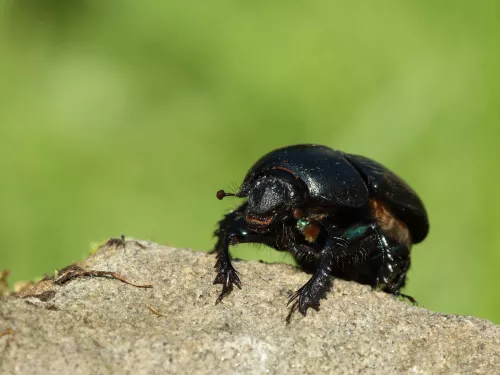Dog's mercury
Often seen carpeting the floor of ancient woodlands, Dog's mercury can quickly colonise, its fresh green leaves shading out rarer plants. It is also very poisonous.
Often seen carpeting the floor of ancient woodlands, Dog's mercury can quickly colonise, its fresh green leaves shading out rarer plants. It is also very poisonous.
Look for the pinky-white flowers of the dog-rose in summer, and its bright red rosehips in autumn. It is a scrambling shrub of hedgerows, woodlands and grasslands.
The striking red twigs and crimson, autumnal leaves of Dogwood make this small shrub an attractive ornamental plant. It can be seen growing wild along woodland edges and hedgerows.
The Downlooker snipefly gets its name from its habit of sitting on posts or sunny trees with its head facing down to the ground, waiting for passing prey. It prefers grassland, scrub and woodland habitats.
A spindly tree of heathland and moorlands, and damp soils, the Downy birch is well known for its paper-thin, white bark. It is so-called for the hairy stalks from which its leaves grow; the Silver Birch is hairless.
This dazzling dragonfly can be seen darting above tree-lined ponds in certain parts of Britain.
With brown-and-orange markings, the Drone-fly looks like a male Honeybee, but is harmless to us. This mimicry helps to protect it from predators while it searches for nectar in gardens and urban areas.

Dung beetles are an often overlooked but hugely important ecosystem engineer. Learn more about them and why we need them in our landscape.
Found along the coast all year-round, the dunlin is a small sandpiper that breeds and winters in the UK. It can be seen in its upland breeding grounds in summer, when it turns brick-red above and sports a black patch on its belly.
The shy dunnock can be seen hopping about under hedges as its other name, 'hedge sparrow', suggests. It inhabits gardens, woodlands, hedgerows and parks.
Dwarf milkwort is a rare plant of chalk and limestone grasslands with short turf; it can mainly be found in Kent, Yorkshire and Cumbria. It has bluish, sometimes pink, flowers atop its short stems.
As its name suggests, the Dwarf thistle is a low-growing plant that is almost stemless - its purple, thistle-like flower heads growing out of a rosette of spiny leaves.